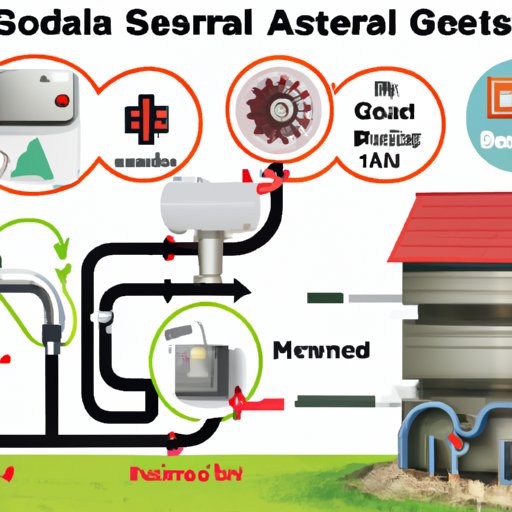Introduction
The global climate crisis has made it increasingly important to reduce our reliance on traditional heating and cooling systems that rely on fossil fuels and emit high levels of carbon dioxide into the atmosphere. One of the most promising alternatives is the use of geothermal heat pumps, which are becoming increasingly popular as an energy-efficient and environmentally-friendly way to heat and cool buildings. But what exactly is a geothermal heat pump, and how does it work? This article will explore the components of geothermal heat pumps, how they work together, the environmental benefits, advantages and disadvantages, cost comparisons, and different installation methods.
Explaining the Components of a Geothermal Heat Pump and How They Work Together
A geothermal heat pump (GHP) is a type of heating and cooling system that uses the constant temperature of the earth to provide heating and cooling for a building. The system consists of four main components: an indoor air handler, an outdoor compressor, an underground loop system, and a ground source heat exchanger. The air handler circulates air throughout the building, while the compressor pumps refrigerant through the system. The underground loop system is made up of pipes that contain a mixture of water and antifreeze, and is buried in the ground. The heat exchanger is connected to the loop system and transfers heat energy between the refrigerant and the ground.
The GHP works by using the constant temperature of the ground to absorb or release heat energy, depending on whether you are trying to heat or cool the building. In the summer, the system absorbs heat from the building and transfers it to the ground via the underground loop system. In the winter, the system absorbs heat from the ground and transfers it to the building. The compressor then pumps the refrigerant through the system, either absorbing or releasing heat energy as needed.

An Overview of the Environmental Benefits of Using a Geothermal Heat Pump
Geothermal heat pumps offer numerous environmental benefits. By relying on the earth’s constant temperature, GHPs require significantly less energy than traditional heating and cooling systems. This reduces the amount of fossil fuels used, resulting in lower carbon emissions. GHPs also conserve natural resources, as they require significantly less water than traditional systems. Finally, they are much more energy efficient, as they can achieve up to 400% efficiency compared to traditional systems, which only achieve around 100%.

Examining the Advantages and Disadvantages of Geothermal Heat Pumps
There are several advantages to using a GHP. First, operating costs are typically lower than with traditional systems, since GHPs require less energy to operate. They also have a longer lifespan, as the underground loop system can last up to 50 years with proper maintenance. Additionally, GHPs are very quiet, as they do not require any noisy fans or compressors.
However, there are also some disadvantages to using a GHP. The initial installation costs can be high, as the system requires a significant amount of excavation and piping. Additionally, GHPs may not be available in certain areas, as they require access to the earth’s constant temperature. Finally, GHPs can potentially have an impact on groundwater levels, as they require a large amount of water to operate.
Comparing Geothermal Heat Pumps to Traditional HVAC Systems
When comparing geothermal heat pumps to traditional HVAC systems, there are several factors to consider. First, cost comparison is important, as GHPs tend to have higher installation costs but lower operating costs. Secondly, performance comparison should be taken into account, as GHPs tend to be more energy efficient and reliable than traditional systems. Finally, maintenance requirements should be examined, as GHPs require more frequent maintenance than traditional systems.
Analyzing the Costs Associated with Installing and Maintaining a Geothermal Heat Pump
The cost of installing a GHP varies depending on the size of the system, the type of loop system used, and the local labor and material costs. Generally speaking, installation costs range from $10,000 to $20,000. Maintenance costs also vary depending on the size of the system and the type of loop system used, but generally range from $500 to $1,000 per year. Other costs to consider include additional excavation costs, the cost of drilling a well, and the cost of energy-efficiency upgrades.

Exploring the Different Installation Methods for Geothermal Heat Pumps
When installing a GHP, there are four different types of loop systems to choose from: horizontal loops, vertical loops, pond/lake loops, and open loops. Horizontal loops involve burying pipes in trenches dug approximately 4 to 6 feet deep. Vertical loops involve digging deeper, usually up to 100 feet, and installing pipes vertically in the holes. Pond/lake loops involve burying pipes in bodies of water such as ponds and lakes. Finally, open loops involve using existing wells or pumping underground water to circulate through the system.
Conclusion
Geothermal heat pumps offer numerous environmental and economic benefits. They are an efficient and cost-effective way to heat and cool buildings, reducing reliance on traditional systems that rely on fossil fuels and emit high levels of carbon dioxide. Although installation costs can be high, GHPs offer lower operating costs and longer lifespans than traditional systems. Additionally, there are several different installation methods to choose from, depending on the specific needs of the building. For those looking for an energy-efficient and environmentally-friendly way to heat and cool their homes, geothermal heat pumps are a great option.
(Note: Is this article not meeting your expectations? Do you have knowledge or insights to share? Unlock new opportunities and expand your reach by joining our authors team. Click Registration to join us and share your expertise with our readers.)
